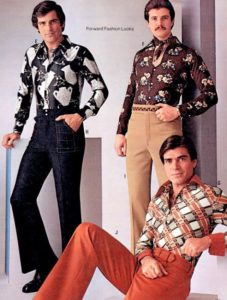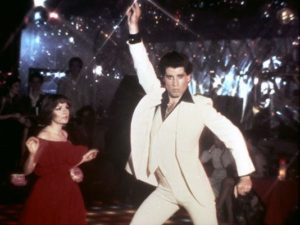
Polyester has become the Mark McGwire of the textiles world. Once prized, it has fallen into disfavor. But it has accomplished a comeback, although the very term “polyester” will conjure up mental images of bright blue leisure suits for years to come.
In 1950, the Du Pont company introduced Dacron polyester. This material, produced mainly from petroleum, was strong enough to be woven into a fabric.
Soon, clothing made of Dacron polyester hit the store shelves. Polyester had many advantages. It could usually be machine washed. It was inexpensive. It was wrinkle-resistant. And it wouldn’t mildew. As the years went by, it became more and more popular.
Parents loved buying their kids durable clothing that was difficult to stain. They loved the idea of suits and ties that could be thrown in the washing machine to completely remove the effects of cherry Kool-Aid.
As the 60’s wore on, polyester clothing began to be a familiar sight. Brightly colored paisleys and flowers were seen on the shirts of the later years of the decade.
As we entered the 70’s, polyester was one of the biggest selling textiles.
Circa 1975, polyester’s demand received a big boost with the advent of the leisure suit. I won’t spend too much time talking about the tieless wonder, as it certainly rates its own column. But times were good for Du Pont, because leisure suits required millions of yards of the ubiquitous artificial fabric.

But it was the birth of Disco that caused polyester’s popularity to hit the ceiling. Who can imagine Saturday Night Fever without polyester? John Travolta’s whiter-than-white leisure suit set the standard for what should be worn while on the dance floor. And a whole bunch of us Boomers complied.
Then, towards the end of the decade, Disco died. Punk took over, followed closely by New Wave. A look took over that was more raw. Leather began covering areas of the human body formerly shielded by polyester.
By the mid 80’s, polyester was ridiculed as a relic of a time when we were dumb enough to wear it and listen to that idiotic Disco music.
Indeed, Disco, which was one of the most eventually reviled popular forms of music ever, took polyester clothing down with it.
Today, polyester manufacturers have been stubbornly trying to remove the 70’s stigma from their product. And, to a large degree, they have succeeded. Microfiber polyester, introduced in 1991, looks and acts very much like silk, without the dry cleaning costs that come with the natural product. And of course, Kevlar, which protects many policemen via bulletproof jackets, is also a form of polyester.
But we Boomer kids can remember bright, satiny shirts and blouses made of the artificial fabric, and we can also remember when wearing them was the height of coolness.
Those flowery polyester shirts would melt to your skin if you dropped a hot cigarette ash on them.